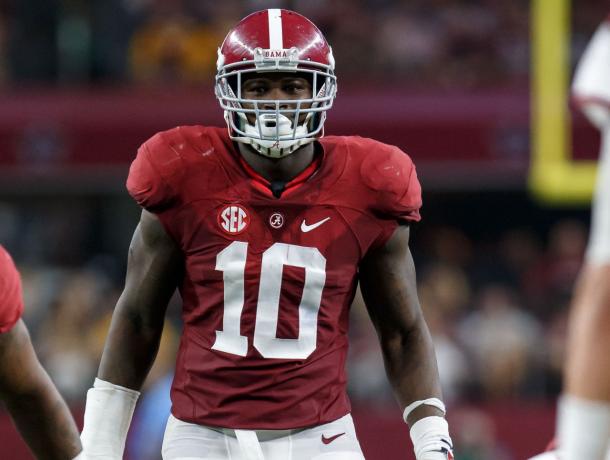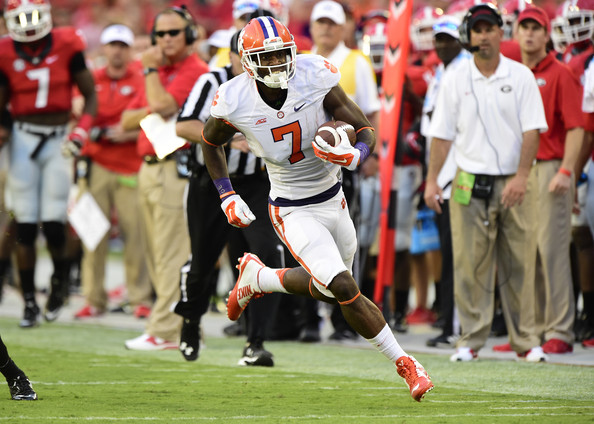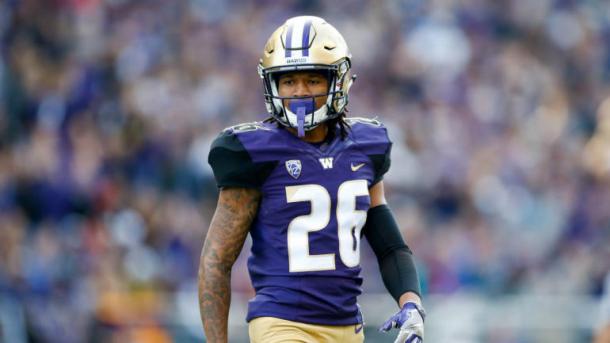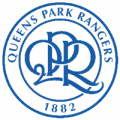As the book of the 2016-17 season closes on 20 of 32 NFL teams, a new chapter awaits on the other side of the Super Bowl. Free agency and the draft are the prologs of a team’s story during the subsequent season. What a team does in the Spring bears fruit in the Fall.
It’s no secret the draft highly influences both a team’s short term and long term successes.Imagine what story would have been told about the top seed in the NFC, the Dallas Cowboys, had looked elsewhere in the first and fourth rounds where they selected Ezekiel Elliott and Dak Prescott, respectively.
This draft season, the intrigue is at an all time high as the top three teams are in search of a new quarterback in a draft with no clear-cut answer at the position. At the time of penning this mock draft, quickly rising names like North Carolina’s Mitch Trubisky and Wyoming’s Josh Allen have not declared for this year’s conscription - although they’ll be conspicuously absent from this projection.
For the sake of intrigue and interest of the reader, this mock draft assumes all eligible underclassmen will be declaring unless they’ve stated otherwise.
The objective of this mock draft is to project what a team’s front office will do and not what the writer believes a team should do. The logic considered behind each pick includes team need, team trends, persisting rumors, and prospect evaluations. Lastly, there will be no trades projected.
1. Cleveland Browns select Myles Garrett, Edge, Texas A&M
It was a shock to many in the 2016 draft when the Cleveland Browns passed on the big armed North Dakota State prospect, Carson Wentz, and modestly traded back to select a receiver, Corey Coleman. The move was a glimpse into the new Cleveland contingent headed by Ivy-League educated number cruncher, Sashi Brown. Surely lured by the whimsy of probability formulas, acquiring more picks will not be on the menu for Sashi this time around considering the team already having two picks in the first round and three in the top 50.
The de facto 2017 number one pick has been Myles Garrett for the better part of the past season and a half. Although he had a career-low in sacks with 8.5, Garrett remains the athletic marvel he was in 2014 and 2015 seasons, when he collected 11 and 11.5 quarterback scalps in each year. Even with some promising pass-rushing talent on the roster, the team only amassed 26 sacks on the year - third worst in the NFL. Further, the Browns were the league’s 30th worst defense overall, according to points per game.
2. San Francisco 49ers select Jonathan Allen, DL, Alabama
With Chip Kelly shown the door before he could change the furniture in San Francisco and G.M. Trent Baalke following him out, the team will look to enter a complete rebuild. Part of that rebuild includes deciding the future at quarterback and whether or not this pick gets used on one.
The last two drafts have netted the 49ers dueling 5-technique-style defensive lineman in Arik Armstead and DeForest Buckner. As luck would have it, Jonathan Allen - a 5-technique - will likely be considered the draft’s next best player after Myles Garrett. Compiling good players is sound practice for NFL teams picking at the top of the draft, regardless of fit. In 2015, the Jets landed one of the draft’s best players in Leonard Williams, despite having similar players in Sheldon Richardson and Mohammad Wilkerson already on the roster. Ultimately, finding creative ways to play three top tier defensive lineman at the same time should be an easy enough task for whoever inherits it.
3. Chicago Bears select Malik Hooker, DB, Ohio State
Of the three teams at the top of the draft, perhaps none need a quarterback more than the Chicago Bears. The late season try-out of Matt Barkley came quickly off the rails as the former USC standout threw for 10 interceptions in his last three games. Still, as was stated in the abstract of this mock, this year’s quarterback class is a perilous one. The player with the most pristine tape - Mitch Trubisky - has too little of it. The one with the elite tools - Deshone Kizer - couldn’t keep a starting job against Malik Zaire. Lastly, the one with the wins - Deshaun Watson - doesn’t appear to be the apple of the NFL’s eye. The most logical step in a no trade scenario would be to take the next best player and many believe that is Ohio State’s Malik Hooker.
Despite only turning in one starting year, Hooker showcased his deep safety talents on a weekly basis at Ohio State. Despite wavering inclinations on entering the league after this season, the playmaking safety punched his ticket to the NFL draft after a tour de force performance against the Championship-bound Clemson Tigers. When addressing the offseason itinerary for the Chicago Bears in a post season presser, G.M. Ryan Pace announced, “I think we need to add more playmakers to our secondary…” With three touchdowns in seven interceptions in 2016, the only players on the Bears who scored more catching the ball than Hooker in 2016 was wide receiver Cameron Meredith.
4. Jacksonville Jaguars select Leonard Fournette, RB, LSU
The 2017 pre-season darlings came up disastrously short finishing 3-13. A perfect storm of regressing from Blake Bortles, a stalled start on defense, and a lack of overall identity haunted the team all season long. Even as it appeared interim head coach Doug Marrone had righted the ship so well staffed with blue-chip talent, a late game blunder to Andrew Luck’s Colts in week 17 became a microcosm of a forgettable year.
Identity is an oft-mentioned, but little-understood part of team building. The Titans did it in 2017 with coach Whisenhunt’s trademarked “exotic-smashmouth” offense and the Patriots have branded their success, The Patriot Way™. Having a perfectly pristine, never removed from the box, Leonard Fournette arrive on their doorstep would give the Jaguars an identity they’ve been looking for. Fournette combines the talents of the all the backs currently on the roster into one while taking the pressure off of Bortles’ shoulders and simplifying the offense behind Fournette’s legs and what was by league’s end a top 10 defense.
5. Tennessee Titans select Reuben Foster, LB, Alabama
Few teams came out better than the Titans did in the 2016 NFL Draft. After trading the first overall pick to the Los Angeles Rams, the Titans netted starters at both right tackle and receiver, while adding quality depth up and down the roster. In 2017, the Titans will be playing with house money and select in the top five via Los Angeles’ first round pick.
If there was one team undone by a key weakness in 2016, it was the Tennessee Titans. Despite being tied for sixth in sacks in the NFL, the Titans were still third worst in defending the pass - giving up nearly 270 yards per game. While cornerback is in play, this is a deep class at the position and the Titans would be wise to wait until their 18th pick to select one. Instead, Alabama’s Reuben Foster, who is the beating heart of inarguably the best defense in college football, is the archetype of a three down, sideline to sideline, player in the NFL who can quickly change the complexion of any defense.

6. New York Jets select Marlon Humphrey, DB, Alabama
2016 was a year to forget for the New York Jets. Central to the Jets’ turmoil was the volatility at quarterback. While it’s unlikely the Jets will leave this draft without drafting another signal caller, it’s hard to imagine the current staff giving up on last year’s second round pick, Christian Hackenberg.
If the team exercises patience with Hackenberg, turning attention to modernizing the defensive side of the ball would be a prudent move. As cornerback Darrelle Revis enters his 11th NFL season at 32 years old, a new face on the perimeter is needed. Alabama’s Marlon Humphrey, who is often overshadowed by his talented teammates, may quickly emerge as the draft’s best corner in a deep group.
7. San Diego Chargers select Jamal Adams, DB, LSU
It was yet another year to forget in San Diego, and it may be the last year to remember in San Diego, too. As the Chargers look north to browner pastures in Los Angeles, the Chargers look to balance the disappointment of consecutive losing years, a closing Super Bowl window with Philip Rivers, hiring a new head coach, and dealing with an unpopular move.
On the bright side, the 2017 draft offers many morsels of encouragement for teams going through tough times. Although the Chargers routinely underperformed this season (something of a point of pride at this point), they will have a number of tough decisions to make in free agency. Oft-injured but talented pass rusher Melvin Ingram and upstart safety Jahleel Addae are both scheduled to be free agents this offseason. While enticing pass rush options like Derek Barnett and Tim Williams persist on the board, LSU strong safety Jamal Adams is among the bluest chips in this draft.
8. Carolina Panthers select Dalvin Cook, RB, Florida State
If there was one team who exemplifies the notion of fleeting NFL success, it was the 2016 Carolina Panthers. After leading the league in scoring offense in 2015, the Panthers fell to 15th in scoring and 19th in yards in 2016. Central to the offensive regression was the devolution of last year’s MVP, Cam Newton.
Still, the team could use some diversification on offense, which still burdens Newton as the alpha and omega of their offensive game planning. With a 29-year old Jonathan Stewart routinely failing to stay on the field and no viable depth behind him, explosive FSU running back Dalvin Cook would be the shot in the arm the offense needs. Cook, who ran for nearly 1,800 yards and added almost 500 yards through the air, gives the offense an element not currently on the roster while dispersing the offense’s responsibility among more elements.
9. Cincinnati Bengals select Corey Davis, WR, Western Michigan
The bottom finally fell out the Marvin Louis era Cincinnati Bengals. After years of pristine regular season performances followed by early playoff exits, the mediocre balance ultimately gave way under the stress of key coaching departures and injuries. Still, the team is well stocked with talent and youth. A week 10 injury to A.J. Green truly felt like the death knell which the Bengals could not recover from as Andy Dalton struggled to gain traction throwing to Brandon Lafell and rookie slot receiver, Tyler Boyd.
Western Michigan’s Corey Davis is the diamond in the rough in this draft class. Playing in sleepy Mid-American Conference makes Davis somewhat of a white whale, but one worth catching. Speaking of catching, Davis caught 326 balls for over 5,000 yards and 51 scores while playing for the Broncos. Andy Dalton is just one year removed from a career year where he had a throng of talented receivers to throw to. A healthy lineup of Green, Davis, Boyd, Eifert, and Bernard out from the backfield would be a throwback to recent history.
10. Buffalo Bills select Mike Williams, WR, Clemson
Despite the team’s best efforts to undo the incredible luck of finding a capable franchise starter through happenstance, the Bills are quick to undermine themselves when it comes to Tyrod Taylor. A perplexing benching during week 17 wreaked of self-sabotage and underhandedness. Still, Doug Whaley endures as the team’s G.M. despite in spite of the fallout of the team’s last few weeks.
Considering the rumors leaking like bile following from a malicious cauldron, the Bills must be closely looking at the quarterback position in this draft. Although there’s no indication Whaley should fear for his job, he may approach the position with prudence considering his previous mishaps. Instead, ensuring the next passer has sufficient talent on the outside to catch the ball should be the first order of business. Just another in a long line of receivers named Mike Williams, this iteration may be the best. Making up for lost time due to last season’s neck injury, Williams presses on in the college football playoffs with over 1,200 yards and 10 touchdowns.

11. New Orleans Saints select Tim Williams, Edge, Alabama
Fixing the defense continues to be priority number one in New Orleans. Considering a historic worst defensive performance a year ago, This season’s 27th ranked yards allowed defense showed signs of life as the season progressed. Though, without potency in the pass rush, the Saints unit will continue on a path to mediocrity. Alabama’s Tim Williams is as pure-bred a pass rusher college football can provide, with 18.5 sacks in two seasons on the Crimson Tide defense.
12. Cleveland Browns select Quincy Wilson, DB, Florida
For a team squarely in a rebuild, there’s no better thing than multiple picks in the top half of the first round. Picking Myles Garrett may prove to be a precocious decision, but the 12th pick leaves room to nuance. Quarterback is in play here, but talent abounds deeper on defense. Nearing 30 years old, cornerback Joe Haden isn’t the player he once was. Like Haden, Quincy Wilson is a product of the Florida Gators. Also like Haden, Wilson is a big-bodied cornerback not shy of NFL-branded contact on the perimeter.
13. Arizona Cardinals select Jalen Tabor, DB, Florida
An unsung part of Arizona’s failings this season was the team’s inability to secure the cornerback position opposite Patrick Peterson. A big part of why the cornerback class is so deep is the amount of power-five conference teams who have more than one to offer an NFL franchise. Florida’s Jalen Tabor will likely join Quincy Wilson in the first round - the only question is which one goes first. If Wilson’s the physical prototype, Tabor is the savvy ballhawk with eight interceptions to his name in three years in Gainesville.
14. Indianapolis Colts select Derek Barnett, Edge, Alabama
A large part of the Colts’ defensive incompetence leaving them third worst in the NFL was a paltry 33 sacks generated by a toothless pass rush. Free agent to be Erik Walden led the team with 11 and may to be back to reprise his role. Tennessee's Derek Barnett recorded 16 sacks in 2016 and 11.5 the year before and projects as one of the draft’s most experienced players off the edge against both the run and pass.
15. Philadelphia Eagles select Sidney Jones, DB, Washington
Even with up to three cornerbacks drafted taken before the midway point of the draft, talent still pours at the position well into the round. The 2016 Eagles managed to field a top 10 defense for much of the year despite a thin secondary. Even if Nolan Carroll is retained this offseason, drafting Washington’s Sidney Jones (another corner cut from the modern mold at 6’ and 218 lbs.) ensures a deep and quality defensive backfield for years to come.

16. Baltimore Ravens select Carl Lawson, Edge, Auburn
Even with aging entities up and down the defensive roster, the 2016 Baltimore Ravens remained near the top of virtually all defensive categories this season. One area where the Ravens came up short was in total sacks, where the Ravens ranked tied for 24th in the league with 31. As Terrell Suggs and Elvis Dumervil enter the twilight of their careers a new face should be brought in to bear the torch. Auburn’s Carl Lawson doesn’t light up the stat sheet - scoring 15 sacks in three seasons with the Tigers - but his strength and size lends himself well for NFL coaching.
17. Washington Redskins select Christian McCaffrey, RB, Stanford
Playing no small part in the Washington Redskins’ third-ranked offense was running back Chris Thompson, whose backfield receiver role saw him setting career highs in rush yards (356), attempts (68), receptions (49), and receiving yards (349). If Thompson is allowed to leave via free agency, there is room to be had for a more well-rounded running back receiver like Stanford’s Christian McCaffrey, whose gaudy college production (over 5,000 scrimmage yards in three years) makes even the most hardened bell cows blush.
18. Tennessee Titans select Marshon Lattimore, DB, Ohio State
Given the aforementioned shortcomings of an underperforming Titans secondary, addressing unit with the team’s second first-round pick is a logical maneuver. Like the Florida duo, Ohio State’s pairing of Marshon Lattimore and Gareon Conley are both players with the athletic wherewithal, size, and skill to be selected within the top 32.
19. Tampa Bay Buccaneers select Cam Robinson, OL, Alabama
Since drafting Jameis Winston first overall in 2015, the Tampa Bay Buccaneers’ seasons have aligned with the quarterback’s steady improvements as a passer. The Bucs added three wins to 2015's total this season and were within earshot of the playoffs, but require more work to secure their franchise signal caller going forward. Alabama’s Cam Robinson is no clear leader of a meager offensive tackle class, but he does have the upside to pay big dividends in both the run and pass game.
20. Denver Broncos select Solomon Thomas, DL, Stanford
While having the league’s fourth-ranked defense per yards allowed and the first ranked defense against the pass, the 2016 Denver Broncos paled in comparison to last year’s dominant defensive unit. Without defensive end Malik Jackson and linebacker Danny Trevathan, the Broncos dropped to the league’s 5th worst run defense. Stanford’s Solomon Thomas has drawn early comparisons to J.J. Watt. Even if he’s half the player Watt is, Thomas would be a sound investment for the Broncos defense.
Stats and information derived from sports-reference.com/cfb/, pro-football-reference.com, NFL.com, and Spotrac.com










































